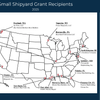NOAA’s National Marine Fisheries Service (NOAA Fisheries) Office for Law Enforcement (OLE) special agents have seized 80 short tons of albacore tuna, worth over $141,000 , from a Cambodian-flagged longline fishing vessel, the Long Man Yun #66 in Pago Pago, American Samoa, for allegedly violating U.S. fishing
laws. The National Oceanic and Atmospheric Administration (NOAA) is an agency
of the Commerce Department.
On August 1, the Long Man Yun #66 was observed within the U.S. Exclusive Economic Zone (EEZ) off American Samoa with significant amounts of fishing gear
on its deck. The crew of the vessel was also observed handling the fishing gear on
the vessel=s working deck. The seizure of the vessel=s catch occurred when the
vessel arrived at dock on September 30.
It is a violation of the Magnuson-Stevens Fishery Conservation and Management Act for a foreign fishing vessel to fail to stow its fishing gear below deck when it is transiting U.S. waters. The requirement to stow gear is intended to ensure that there is never a question as to whether a foreign fishing vessel observed transiting U.S. waters has been illegally fishing. The fishing vessel was spotted in the U.S. EEZ off of American Samoa by a NOAA OLE special agent flying aboard a U.S. Coast Guard C-130 aircraft on a standard fisheries patrol. The U.S. EEZ is a vast and remote expanse of water which often requires both ship and aircraft patrols to enforce U.S. fisheries laws.
With the fishing gear being handled on deck, there is a significant likelihood that the vessel was recently fishing illegally in U.S. waters, or was preparing to do so. As such, we treat violations involving foreign vessels with un-stowed gear as seriously as we do those where there is specific evidence of actual illegal fishing in U.S. waters. The penalties for these types of violations include forfeiture of the catch and a significant monetary fine, said Special Agent in Charge Mike Gonzales - NOAA Fisheries OLE - Southwest Division.
The case is currently under investigation and will be turned over to NOAA’s General Counsel for Enforcement and Litigation for review.













